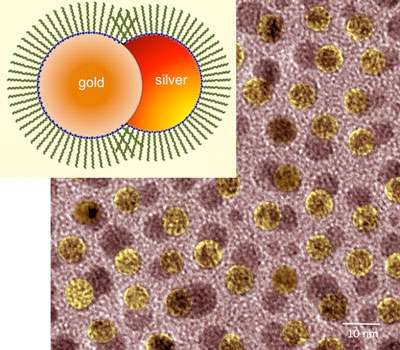Surface plasmon resonance in interfaced heterodimers

High-quality interfaced Au-Ag heterodimers in the quantum size regime (diameter <10 nm) were synthesized through a seed-mediated, surface-confined epitaxial overgrowth strategy by researchers in the Nanophotonics Group at Argonne National Laboratory. First-principles calculations by the Theory & Modeling Group confirmed that quantum size effects and formation of Au/Ag interfaces lead to an unusual enhancement of the characteristic gold surface plasmon resonance and the emergence of a charge-transfer plasmon across the Au/Ag domains. To our knowledge, the enhanced plasmonic performance due to Au/Ag charge-transfer plasmon resonance has not been described before.
One of the great promises of nanotechnology is the ability to control and confine light on length scales that are orders of magnitude smaller than optical wavelengths by exploiting a phenomenon known as plasmons, which are collective oscillations of conduction electrons in metals excited by visible light. This promise is particularly tantalizing when the size of plasmonic structures approach the molecular scale (<10 nm) because it opens avenues for catalysis, sensing, and certain medical applications. However, it is generally supposed that the performance of plasmonic materials degrades significantly at this scale because of the onset of quantum-mechanical effects.
A surprising enhancement was observed in this size regime when two different materials (silver and gold) were interfaced. Through theoretical modeling and quantum-mechanical calculations, quantum effects were determined to be responsible for this enhancement by creating a stronger condition for a "charge-transfer plasmon" resonance. The insight gained about this new mechanism may suggest general strategies for overcoming losses in plasmonic performance in the quantum size regime.
More information: Y. Sun et al., Interfaced Metal Heterodimers in the Quantum Size Regime, Nano Lett., 13, 3958 (2013).
Journal information: Nano Letters
Provided by Argonne National Laboratory




















